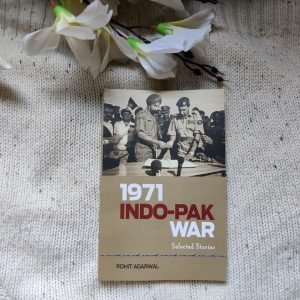71 Dash to Dhaka by G.D. Bakshi
৳ 270.00 – ৳ 350.00
The 1971 war for the Liberation of Bangladesh was a landmark conflict in the history of South Asia. It dramatically changed the map of this region and marked a historical revival of Indian military power. In just 13 glorious and action packed days – three Indian corps sized spear heads raced for the capital city of Dacca. It was located in the most defensible, riverine terrain in the world. Yet the Indian Blitzkrieg bounced the wide rivers using Helicopters and Paradrops to speed up operations and paralyse the enemy command centre with precision air attacks. The India Air Force generated shock and awe over the battlefields of Bangladesh. Like an expanding torrent of water, the Indian Army bypassed all major centres of opposition in its race for Dacca. Meanwhile the Indian Navy blockaded East and West Pakistan and cut off the two wings of the country. Thus in 13 nail biting days the Indian forces marched on an enemy capital, enforced regime change and induced the largest mass surrender of forces. These were decisive results. This despite the American Seventh Fleet – led by the US aircraft carrier Enterprise, making menacing moves in the bay of Bengal. This is the behind the scenes account of that war – how the critical decisions were arrived at – what major risks were taken and the superb planning and coordination between all organs of the Indian state – political, military, diplomatic and intelligence. It was India’s finest hour. It unconsciously revived the Kautiliyan paradigm of war-fighting. The 1971 War for the Liberation of Bangladesh was a historic and epochal conflict that decisively changed the map of South Asia and created a new nation-state with the force of arms. It was a classic tri-service campaign that exhibited dramatic levels of synergy and coordination. It witnessed the march upon an enemy capital, enforced regime change and the mass surrender of armies. These are the hallmarks of a decisive military campaign. The Bangladesh War was a landmark conflict of that era because it broke the Cold War-era pattern of stalemated conflicts, where no victor or vanquished was allowed to emerge for fear of escalation and the involvement of the two nuclear armed super-powers of that era. The super powers would simply not let their client states get defeated or militarily overwhelmed. India broke this pattern by winning an outright military victory – a first in that era of stalemated and limited conflicts. What is even more creditable was the fact that this was achieved in the teeth of fierce opposition by the United States, militarily the strongest super power of the world.
The 1971 war for the Liberation of Bangladesh was a landmark conflict in the history of South Asia. It dramatically changed the map of this region and marked a historical revival of Indian military power. In just 13 glorious and action packed days – three Indian corps sized spear heads raced for the capital city of Dacca. It was located in the most defensible, riverine terrain in the world. Yet the Indian Blitzkrieg bounced the wide rivers using Helicopters and Paradrops to speed up operations and paralyse the enemy command centre with precision air attacks. The India Air Force generated shock and awe over the battlefields of Bangladesh. Like an expanding torrent of water, the Indian Army bypassed all major centres of opposition in its race for Dacca. Meanwhile the Indian Navy blockaded East and West Pakistan and cut off the two wings of the country. Thus in 13 nail biting days the Indian forces marched on an enemy capital, enforced regime change and induced the largest mass surrender of forces. These were decisive results. This despite the American Seventh Fleet – led by the US aircraft carrier Enterprise, making menacing moves in the bay of Bengal. This is the behind the scenes account of that war – how the critical decisions were arrived at – what major risks were taken and the superb planning and coordination between all organs of the Indian state – political, military, diplomatic and intelligence. It was India’s finest hour. It unconsciously revived the Kautiliyan paradigm of war-fighting. The 1971 War for the Liberation of Bangladesh was a historic and epochal conflict that decisively changed the map of South Asia and created a new nation-state with the force of arms. It was a classic tri-service campaign that exhibited dramatic levels of synergy and coordination. It witnessed the march upon an enemy capital, enforced regime change and the mass surrender of armies. These are the hallmarks of a decisive military campaign. The Bangladesh War was a landmark conflict of that era because it broke the Cold War-era pattern of stalemated conflicts, where no victor or vanquished was allowed to emerge for fear of escalation and the involvement of the two nuclear armed super-powers of that era. The super powers would simply not let their client states get defeated or militarily overwhelmed. India broke this pattern by winning an outright military victory – a first in that era of stalemated and limited conflicts. What is even more creditable was the fact that this was achieved in the teeth of fierce opposition by the United States, militarily the strongest super power of the world.
| Type | Hardcover, Paperback |
|---|
You must be logged in to post a review.






Reviews
There are no reviews yet.